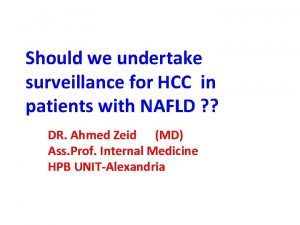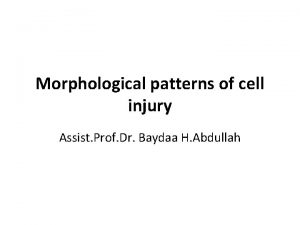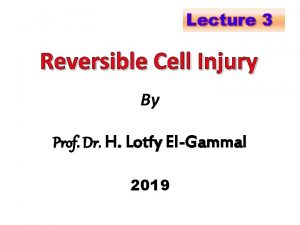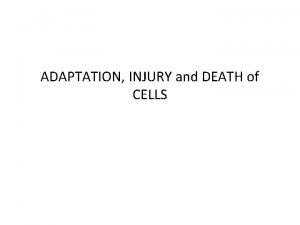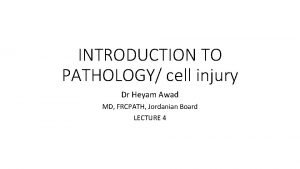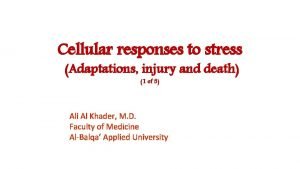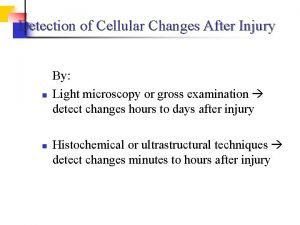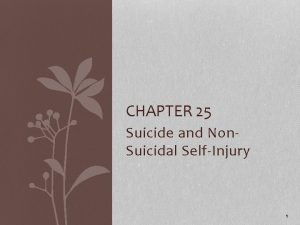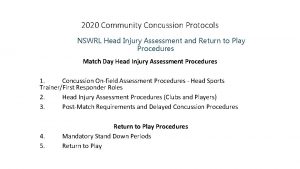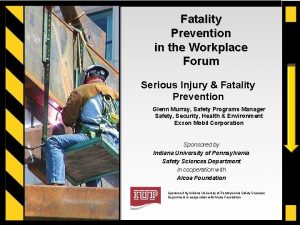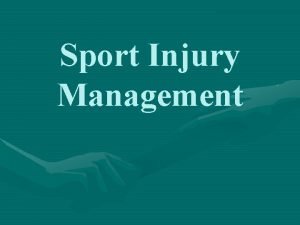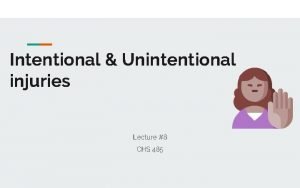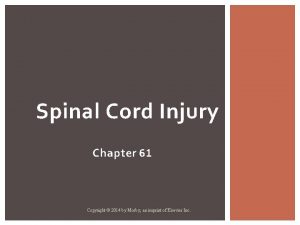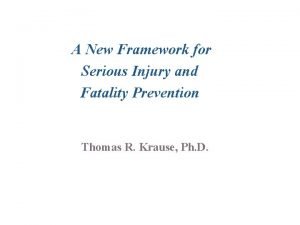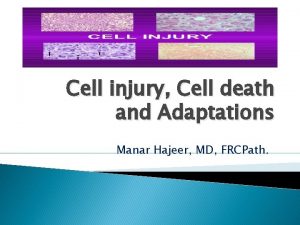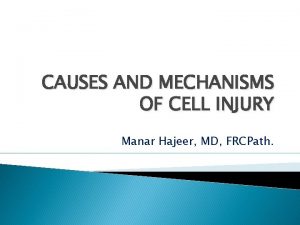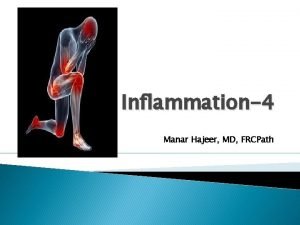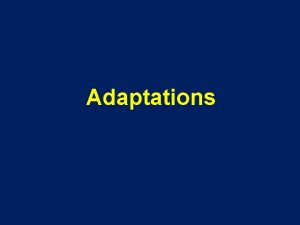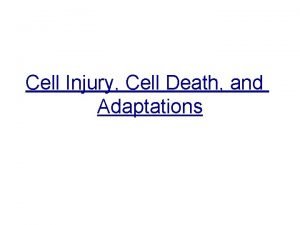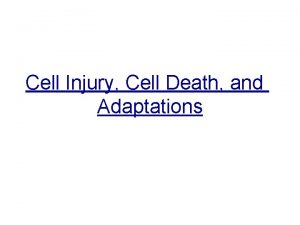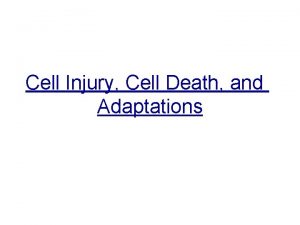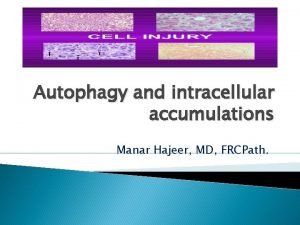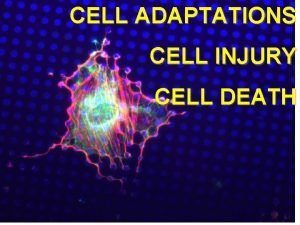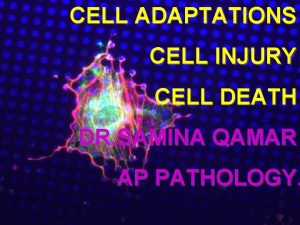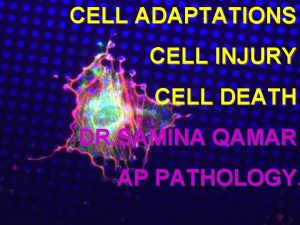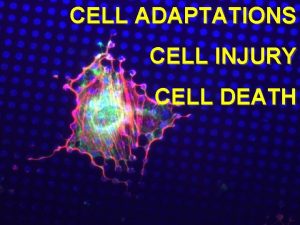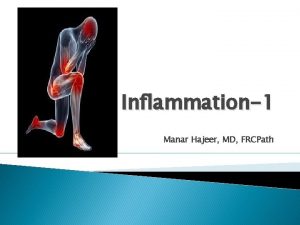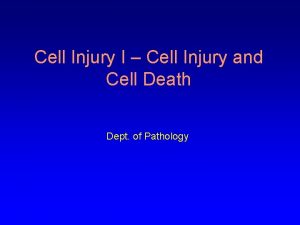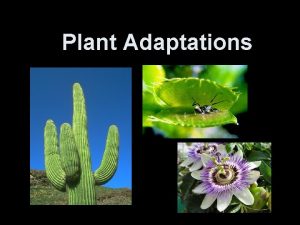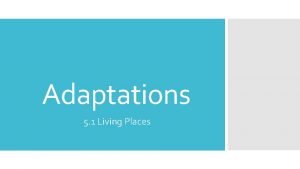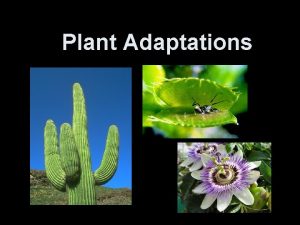Cell injury Cell death and Adaptations Manar Hajeer



























- Slides: 27

Cell injury, Cell death and Adaptations Manar Hajeer, MD, FRCPath University of Jordan , school of medicine

Cells Tissues Organs Systems Organism



Adaptations � Physiologic adaptation � Pathologic adaptation.

Adaptations Many forms: Ø Increase in cell size. Ø Increase in number of cells. Ø Change into another type of cell Ø � Adaptation to stress can progress to cell injury if the stress is not relieved.

Hypertrophy • • • Increased size & functional capacity Pure or mixed Increased structural proteins and organelles. Pathologic vs physiologic Due to • hormonal stimulation • Growth factor stimulation • increased functional demand

Pathologic cardiac muscle in hypertension and aortic stenosis

Physiologic uterine smooth muscle in pregnancy

Physiologic skeletal muscle in athletes

Hyperplasia • • • Increase in number of cells Tissues that have proliferative ability Pure vs Mixed Physiologic vs Pathologic vs cancer Physiologic hyperplasia: • hormonal stimulation • Compensatory • � Pathologic hyperplasia • excessive hormonal stimulation • Viral Infections Pathologic hyperplasia constitutes a fertile soil in which cancers may eventually arise.

� Physiologic � Breast in puberty and pregnancy � Liver after partial resection � Pathologic � Endometrial hyperplasia, estrogen induced. � Benign prostatic hyperplasia, androgen induced. � Warts (HPV).

Physiologic breast in pregnancy and lactation

Pathologic endometrial hyperplasia, estrogen induced

Atrophy Ø Decreased cell size & function Ø Mechanism: ↓ Protein synth ↑ Degradation ↑ Autophagy Ø Atrophic cells can still function

Causes: � � � Decreased workload (immobilization of a limb after fracture) Loss of innervations Diminished blood supply, Inadequate nutrition Loss of endocrine stimulation Aging (senile atrophy)

� Physiologic � Loss of hormone stimulation in menopause (endometrial atrophy) � Pathologic � Denervation injury. � Chronic ischemia.

Metaplasia Ø Ø Ø Change from one cell type to another Reprogramming of stem cells NOT differentiated cells Persistent change increases risk of cancer New cell type copes better with stress but function less. Reversible Causes: Smoking , Vitamin A deficiency, GERD.

Cell injury and death

CAUSES OF CELL INJURY Ø Oxygen Deprivation (Hypoxia Vs ischemia) Ø Chemical Agents Ø Infectious Agents Ø Immunologic Reactions Ø Genetic Factors Ø Nutritional Imbalances Ø Physical Agents Ø Aging

Oxygen Deprivation

Chemical Agents

Infectious Agents

Immunologic Reactions autoimmune, allergic, microbes

Genetic Factors

Nutritional Imbalances

Physical Agents
 How to protect yourself from intentional injuries
How to protect yourself from intentional injuries Cell injury and inflammation
Cell injury and inflammation Dry vs wet gangrene
Dry vs wet gangrene Difference between somatic and molecular death
Difference between somatic and molecular death Russell bodies
Russell bodies Genetic causes of cell injury
Genetic causes of cell injury Necrosis
Necrosis Myelin figures in reversible cell injury
Myelin figures in reversible cell injury Example of physiological hyperplasia
Example of physiological hyperplasia Reversible cell injury
Reversible cell injury Injuries first aid
Injuries first aid The sad persons scale
The sad persons scale A spill at parsenn bowl: knee injury and recovery
A spill at parsenn bowl: knee injury and recovery Nrl head injury recognition and referral form
Nrl head injury recognition and referral form Workplace fatality prevention
Workplace fatality prevention Safety practices and sports injury management pictures
Safety practices and sports injury management pictures Intentional injury
Intentional injury Somi brace
Somi brace Serious injury and fatality prevention
Serious injury and fatality prevention Advantages and disadvantages of diaphragm cell process
Advantages and disadvantages of diaphragm cell process Prokaryotic and eukaryotic cells
Prokaryotic and eukaryotic cells Venn diagram plant and animal cells
Venn diagram plant and animal cells Tonoplast
Tonoplast Plant cell and animal cell
Plant cell and animal cell Primary battery and secondary battery
Primary battery and secondary battery Differences between plant animal and bacterial cells
Differences between plant animal and bacterial cells Events of the cell cycle
Events of the cell cycle Life
Life

